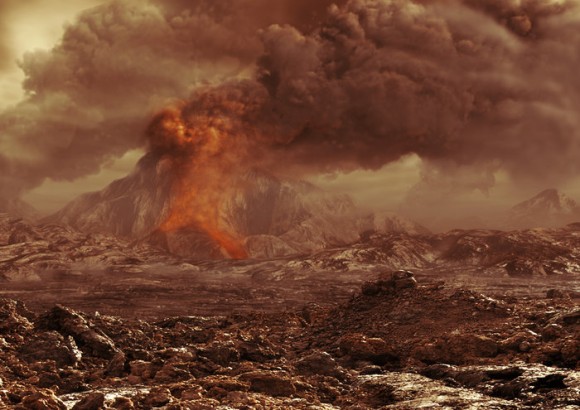
Scientists know that volcanoes have crackled on the surface of Venus for much of the planet’s history. Now, using data from the European Space Agency’s (ESA) Venus Express spacecraft, an international team of researchers has found new evidence that suggests some of those Venusian volcanoes are still active.
In combing through Venus Express, the scientists found transient spikes in temperature at several spots on the planet’s surface. The hotspots, which were found to flash and fade over the course of just a few days, appear to be generated by active flows of lava on the surface.
The research was published online in Geophysical Research Letters in May, 2015.

Enjoying EarthSky? Sign up for our free daily newsletter today!
Seeing the surface of Venus is extremely difficult due to its thick atmosphere, but radar observations by previous missions to Venus have revealed it as a world covered in volcanoes and ancient lava flows.
Venus is almost exactly the same size as Earth and has a similar bulk composition, so is likely to have an internal heat source, perhaps due to radioactive heating. This heat has to escape somehow, and one possibility is that it does so in the form of volcanic eruptions.
Some models of planetary evolution suggest that Venus was resurfaced in a cataclysmic flood of lava around half a billion years ago. But whether Venus is active today has remained a hot topic in planetary science.
The latest finding is consistent with other data from Venus Express that have hinted at very recent volcanic activity. In 2010, infrared imaging from several volcanoes seemed to indicate lava flows from thousands to a few million years old. A few years later, scientists reported transient spikes in sulfur dioxide in Venus’ upper atmosphere, another potential signal of active volcanism.
Now, using a near-infrared channel of the spacecraft’s Venus Monitoring Camera (VMC) to map thermal emission from the surface, the team of planetary scientists has spotted localized changes in surface brightness between images taken only a few days apart.
Eugene Shalygin from the Max Planck Institute for Solar System Research (MPS) in Germany is lead author of the paper. Shalygin said:
We have now seen several events where a spot on the surface suddenly gets much hotter, and then cools down again.
These four ‘hotspots’ are located in what are known from radar imagery to be tectonic rift zones, but this is the first time we have detected that they are hot and changing in temperature from day to day. It is the most tantalizing evidence yet for active volcanism.
The hotspots are found along the Ganiki Chasma rift zone close to the volcanoes Ozza Mons and Maat Mons. Rift zones are results of fracturing of the surface, which is often associated with upwelling of magma below the crust. This process can bring hot material to the surface, where it may be released through fractures as a lava flow.
The Ganiki Chasma rift zone was already considered to be one of the most recently geologically active regions on the planet, and as the new analysis suggests, it is still active today.
Håkan Svedhem is ESA’s Venus Express project scientist. He said:
It looks like we can finally include Venus in the small club of volcanically active solar system bodies.
Our study shows that Venus, our nearest neighbor, is still active and changing in the present day. It is an important step in our quest to understand the different evolutionary histories of Earth and Venus.
Bottom line: Using data from the European Space Agency’s (ESA) Venus Express spacecraft, an international team of researchers has found new evidence that suggests some of those Venusian volcanoes are still active.











